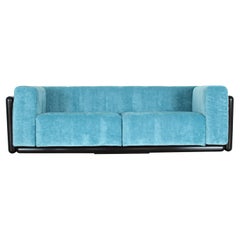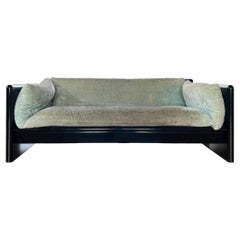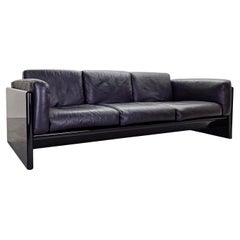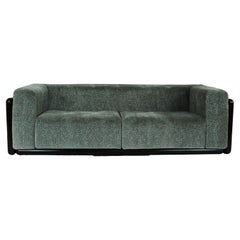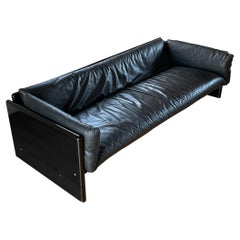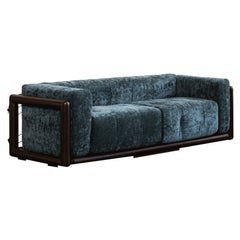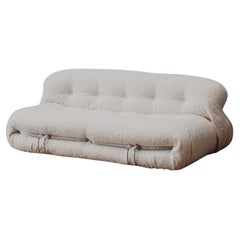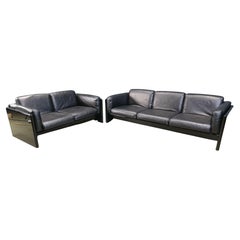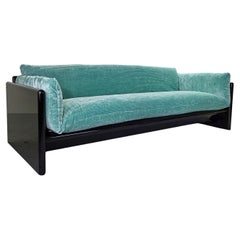Studio Simon Sofas
to
1
5
5
Height
to
Width
to
Depth
to
5
5
5
1
4
4
4
4
4
3
3
5
5
5
5
5
11
444
300
189
181
Creator: Studio Simon
Carlo Scarpa Iroko Wood and Azure Velvet Cornaro Sofa for Studio Simon, 1974
By Studio Simon, Carlo Scarpa
Located in Vicenza, IT
Cornaro two-seater sofa, designed by Carlo Scarpa and manufactured by Studio Simon in 1974.
Made of Iroko wood, foam, and azure velvet by JAB.
Fully restored in Italy.
Born in Ven...
Category
1970s Italian Mid-Century Modern Vintage Studio Simon Sofas
Materials
Chenille, Velvet, Foam, Wood
Studio Simon Black Wood and Azure Velvet Two-Seater “Simone” Sofa, Italy, 1975
By Studio Simon
Located in Vicenza, IT
Two-seater “Simone” sofa, designed and manufactured by Studio Simon in 1975.
The structure is made of black lacquered wood. An azure velvet big seat completes the sofa.
The min...
Category
1970s Italian Mid-Century Modern Vintage Studio Simon Sofas
Materials
Cotton, Velvet, Foam
Lacquered 3-seater sofa and leather Studio Simon by Gavina
By Dino Gavina, Studio Simon
Located in Milano, MI
Elegant "Simone" Sofa Designed by Dino Gavina for Studio Simon in the 1970s.
Cushions upholstered in black leather and polyester lacquered wood frame, glossy black.
Sofa frame solid...
Category
Mid-20th Century Italian Mid-Century Modern Studio Simon Sofas
Materials
Leather, Wood
$7,455 Sale Price
35% Off
Carlo Scarpa Iroko Wood and Jacquard Velvet Cornaro Sofa for Studio Simon, 1974
By Carlo Scarpa, Studio Simon
Located in Vicenza, IT
Cornaro two-seater sofa, designed by Carlo Scarpa and manufactured by Studio Simon in 1974.
Made of Iroko wood, foam, and light blue jacquard velvet by Zimmer + Rohde.
Fully restor...
Category
1970s Italian Mid-Century Modern Vintage Studio Simon Sofas
Materials
Chenille, Velvet, Foam, Wood
Studio Simon Minimalist Black Leather Three-Seater “Simone” Sofa, Italy, 1975
By Studio Simon
Located in Vicenza, IT
Three-seater “Simone” sofa, designed and manufactured by Studio Simon in 1975.
The structure is made of black lacquered wood. A black leather big seat completes the sofa.
The minim...
Category
1970s Italian Mid-Century Modern Vintage Studio Simon Sofas
Materials
Leather, Foam, Beech
Related Items
Carlo Scarpa “Cornaro” Two-seater Sofa for Gavina, Turquoise Velvet, 1973
By Carlo Scarpa, Gavina
Located in Lonigo, Veneto
Carlo Scarpa “Cornaro” sofa for Gavina, wood and turquoise velvet, 1973.
The Cornaro sofa represents a sublime exemplification of the harmon...
Category
1970s Italian Post-Modern Vintage Studio Simon Sofas
Materials
Velvet, Foam, Wood
$23,650
H 25.6 in W 86.62 in D 33.47 in
Afra & Tobia Scarpa “Soriana” Sofa for Cassina, Ivory Bouclé, 1969
By Afra & Tobia Scarpa, Cassina
Located in Lonigo, Veneto
Afra & Tobia Scarpa “Soriana” two-seater sofa for Cassina, ivory bouclé, Italy, 1969.
Although technically designed in the 1960s, the "Soriana" model by the Italian duo Tobia and Afra Scarpa is firmly associated with the next decade, when its popularity peaked. "Soriana" is low and invites you to sink into its curves. The most notable feature of this couch, however, is the Minimalist structure in chromed steel. This external structure in steel rod keeps the cover taut using buttons...
Category
1960s Italian Mid-Century Modern Vintage Studio Simon Sofas
Materials
Bouclé
$13,000
H 25.6 in W 68.9 in D 39.38 in
Carlo Scarpa “Cornaro” Three-seater Sofa for Gavina, Ivory Velvet, 1973
By Carlo Scarpa, Gavina
Located in Lonigo, Veneto
Carlo Scarpa “Cornaro” sofa for Gavina, wood and ivory velvet, 1973.
The Cornaro sofa represents a sublime exemplification of the harmony between Japanese minimalism and Ultraration...
Category
1970s Italian Post-Modern Vintage Studio Simon Sofas
Materials
Velvet, Foam, Wood
$35,200
H 25.6 in W 118.12 in D 33.47 in
Carlo Scarpa “Cornaro” Three-seater Sofa for Gavina, Ivory Linen, 1973
By Carlo Scarpa, Gavina
Located in Lonigo, Veneto
Carlo Scarpa “Cornaro” sofa for Gavina, wood and ivory linen, Italy, 1973.
The Cornaro sofa represents a sublime exemplification of the harmony between...
Category
1970s Italian Post-Modern Vintage Studio Simon Sofas
Materials
Velvet, Foam, Wood
$35,200
H 25.6 in W 118.12 in D 33.47 in
Afra & Tobia Scarpa “Soriana” Sofa for Cassina, Green Velvet
By Afra & Tobia Scarpa, Cassina
Located in Lonigo, Veneto
Afra & Tobia Scarpa “Soriana” sofa for Cassina, green velvet, Italy
Although technically designed in the 1960s, the "Soriana" model by the Italian duo Tobia and Afra Scarpa is firm...
Category
1970s Italian Mid-Century Modern Vintage Studio Simon Sofas
Materials
Stainless Steel
LUXURY VIVA ITALIAN DESIGNER TAN LEATHER 3 SEATER SOFA ARMCHAiR ALSO AVAILABLE
Located in West Sussex, Pulborough
We are delighted to offer for sale this luxury Viva Italian designer tan leather 3 seater sofa.
A stunning designer collection with boastful proportions. ...
Category
20th Century Italian Mid-Century Modern Studio Simon Sofas
Materials
Leather
$1,996
H 35.44 in W 77.56 in D 34.85 in
Mid-Century Modern Italian Three-Seat "Coronado" Sofa by Tobia Scarpa for B&B
By Tobia Scarpa, B&B Italia
Located in Prato, IT
Mid-Century Modern Italian three-seat flamingo pink velvet "Coronado" sofa by Tobia Scarpa for B&B. Project from 1960s
The sofa can come as a living room set together with its pair ...
Category
1970s Italian Mid-Century Modern Vintage Studio Simon Sofas
Materials
Velvet, Wood
$4,683
H 29.93 in W 84.65 in D 35.44 in
4-Seater Sofa Gray Leather with Silk and Leather Cushions, Sormani Italy, 1980s
By Sormani, Luigi Sormani and Casabella Design Miami
Located in Arosio, IT
This four-seater, designed in the early 1980s by Luigi Sormani and Casabella Miami for a line of maxi-furniture destined to the United States is a comfortable one-block sofa for a luxury villa. The structure is in a warm gray leather and the fabric was especially made for this series called "Intrigue": a special very light grey silk fabric interwoven with burgundy leather threads. All cushions have grey leather inlays, entirely hand sewn. Julio Iglesias...
Category
1980s Italian Minimalist Vintage Studio Simon Sofas
Materials
Leather, Fabric
$9,848
H 28.35 in W 118.12 in D 35.44 in
Vintage Minimalist German Black Leather & Chrome Modular Sofa from Klöber
By Klöber
Located in Warszawa, Mazowieckie
This modular sofa was produced by Klöber, a German manufactory founded in 1935. It consists of four separate lounge chairs in black leather. The minimalist base is made from chrome-p...
Category
1980s German Minimalist Vintage Studio Simon Sofas
Materials
Steel, Chrome
$5,279 Sale Price / set
20% Off
H 30.32 in W 24.41 in D 31.5 in
Kaare Klint Two-Seat Sofa for Rud. Rasmussen
By Rud Rasmussen, Kaare Klint
Located in Copenhagen, DK
Kaare Klint freestanding two-seat sofas on six-legged, profiled mahogany cross-frame. Sides, seat and back upholstered with black horsehair. Executed by Rud. Rasmussen, Copenhagen.
Category
Mid-20th Century Danish Scandinavian Modern Studio Simon Sofas
Materials
Leather, Mahogany
Carlo Scarpa “Cornaro” Two-seater Sofa for Gavina, Ivory Velvet, 1973
By Gavina, Carlo Scarpa
Located in Lonigo, Veneto
Carlo Scarpa “Cornaro” sofa for Gavina, wood and ivory velvet, 1973.
The Cornaro sofa represents a sublime exemplification of the harmony be...
Category
1970s Italian Post-Modern Vintage Studio Simon Sofas
Materials
Velvet, Foam, Wood
$21,600
H 25.6 in W 86.62 in D 33.47 in
Tobia Scarpa White Lacquered Sofa 3 Seats Model Bastiano for Gavina, Italy 1960s
By Afra & Tobia Scarpa
Located in Paris, FR
White lacquered sofa 3 seats model Bastiano by Tobia Scarpa for Gavina italy 1960s
The lot is in good overall condition with no cracks or mis...
Category
Mid-20th Century Italian Mid-Century Modern Studio Simon Sofas
Materials
Velvet, Wood, Lacquer
$9,367
H 29.53 in W 82.68 in D 30.71 in
Previously Available Items
Vintage lacquer and leather sofa set by Kazuhide Takahama for Studio Simon, 1970
By Studio Simon, Kazuhide Takahama
Located in Leuven, Vlaams Gewest
Rare vintage sofa set designed by Kazuhide Takahama for Studio Simon.
Beautiful black lacquered panels with comfy black leather cushions.
The sofas are labelled underneath the cush...
Category
1970s Italian Minimalist Vintage Studio Simon Sofas
Materials
Leather, Lacquer
H 27.56 in W 86.62 in D 33.47 in
Sofa "Simone" 3 seater Studio Simon by Gavina glossy black lacquered
By Gavina, Studio Simon
Located in Milano, MI
Elegant "Simone" Sofa Designed by Dino Gavina for Studio Simon in the 1970s.
The black glossy lacquered wood frame allows it to be placed in the center of the room having a very eleg...
Category
Mid-20th Century Italian Mid-Century Modern Studio Simon Sofas
Materials
Velvet, Wood
H 22.05 in W 82.68 in D 31.89 in
Studio Simon Minimalist Black Leather Three-Seater “Simone” Sofa, Italy, 1975
By Studio Simon
Located in Vicenza, IT
Three-seater “Simone” sofa, designed and manufactured by Studio Simon in 1975.
The structure is made of black lacquered wood. A black leather big seat completes the sofa.
The m...
Category
1970s Italian Mid-Century Modern Vintage Studio Simon Sofas
Materials
Foam, Leather, Beech
H 20.48 in W 82.68 in D 31.89 in
Dino Gavina Pair of Blue Velvet 'Simone' Sofas for Studio Simon, 1971
By Dino Gavina, Studio Simon
Located in Tilburg, NL
Dino Gavina (1922-2007) rare pair of blue velvet 'Simone' sofas for Studio Simon 1971. Black lacquered high gloss wooden frame and blue velvet upholstery.
Striking pair of sofas ...
Category
Mid-20th Century Italian Post-Modern Studio Simon Sofas
Materials
Fabric, Velvet, Wood, Lacquer
H 22.45 in W 84.26 in D 31.5 in
Simone Sofa by
Ufficio Progetti Gavina for Simon International
By Ufficio Progetti Gavina, Studio Simon
Located in Dronten, NL
Simone two-seat sofa by Simon International. Structure in signature Simon International gloss lacquered wood.
Original black leather upholstery in great vintage condition.
Marked S...
Category
1970s Italian Mid-Century Modern Vintage Studio Simon Sofas
Materials
Leather, Wood
Studio Simon sofas for sale on 1stDibs.
Studio Simon sofas are available for sale on 1stDibs. These distinctive items are frequently made of wood and are designed with extraordinary care. There are many options to choose from in our collection of Studio Simon sofas, although brown editions of this piece are particularly popular. Many of the original sofas by Studio Simon were created in the mid-century modern style in italy during the 20th century. If you’re looking for additional options, many customers also consider sofas by Claudio Salocchi, Sergio Asti, and Dino Gavina. Prices for Studio Simon sofas can differ depending upon size, time period and other attributes — on 1stDibs, these items begin at $3,019 and can go as high as $40,049, while a piece like these, on average, fetch $8,900.
Creators Similar to Studio Simon
Guglielmo Veronesi
